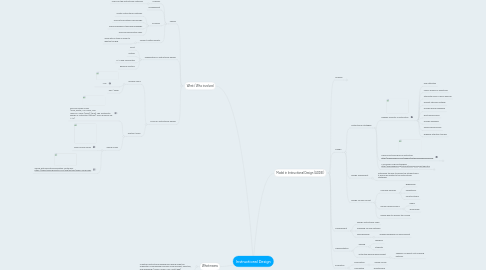
1. What / Who involved
1.1. People
1.1.1. Learners
1.1.1.1. Users for the Instructional Materials
1.1.2. Management
1.1.3. ID Teams
1.1.3.1. Create Instructional Materials
1.1.3.2. Good at Educational Technology
1.1.3.3. Well knowledge in teaching pedagogy
1.1.3.4. Good communication skills
1.1.4. Subject Matter Experts
1.1.4.1. Work with ID team in order to identify the gap
1.2. Organization in Instructional Design
1.2.1. Gov't
1.2.2. Military
1.2.3. K-12 and Universities
1.2.4. Business Sectors
1.3. Tools for Instructional Design
1.3.1. Physical Tools
1.3.1.1. LMS
1.3.1.2. Pen / Paper
1.3.2. Abstract Tools
1.3.2.1. Dick and Carey Model (Dick, Walter, Lou Carey, and James O. Carey (2005) [1978]. The Systematic Design of Instruction (6th ed.). Allyn & Bacon. pp. 1–12.)
1.3.2.2. ADDIE Model
1.3.2.2.1. Basic ADDIE Model
1.3.2.2.2. ADDIE with Formative evaluation continually https://www.trainingindustry.com/wiki/entries/addie-model.aspx
2. Model in Instructional Design (ADDIE)
2.1. Analysis
2.1.1. Identify the Gap (Performance Analysis)
2.1.1.1. Blanchard & Thacker process model
2.1.1.2. Need Assessment
2.1.1.2.1. Optimal Performance
2.1.1.2.2. Actual Performance
2.1.1.2.3. Identify Stakeholders
2.1.2. Leaner Analysis
2.1.2.1. Maslow’s hierarchy of needs
2.1.2.2. The Adult Learning Theory - Malcom Knowles
2.1.2.2.1. Knowles’ 5 Assumptions Of Adult Learners (Knowles, M. (1984). The Adult Learner: A Neglected Species (3rd Ed.). Houston, TX: Gulf Publishing.)
2.1.2.2.2. Knowles’ 4 Principles Of Andragogy (Knowles, M. (1984). Andragogy in Action. San Francisco: Jossey-Bass.)
2.1.3. Task Analysis
2.1.3.1. Hierarchical Task Diagram
2.1.3.1.1. Identify the task which perform actually
2.1.3.1.2. Determine the conditions that perform the task
2.1.3.2. Determine Job Standard
2.1.4. Identify Learning Objectives
2.1.4.1. ABCD Approach
2.1.4.1.1. Audience
2.1.4.1.2. Behavior
2.1.4.1.3. Conditions
2.1.4.1.4. Degree
2.1.4.2. Bloom's Taxonomy http://www.instructionaldesigncentral.com/htm/IDC_instructionaldesignmodels.htm#bloom
2.1.4.2.1. Knowledge: arrange, define, duplicate, label, list, memorize, name, order, recognize, relate, recall, repeat, reproduce state
2.1.4.2.2. Understanding: classify, describe, discuss, explain, express, identify, indicate, locate, recognize, report, restate, review, select, translate
2.1.4.2.3. Application: apply, choose, demonstrate, dramatize, employ, illustrate, interpret, operate, practice, schedule, sketch, solve, use, write
2.1.4.2.4. Analysis: analyze, appraise, calculate, categorize, compare, contrast, criticize, differentiate, discriminate, distinguish, examine, experiment, question, test
2.1.4.2.5. Synthesis: arrange, assemble, collect, compose, construct, create, design, develop, formulate, manage, organize, plan, prepare, propose, set up, write
2.1.4.2.6. Evaluation: appraise, argue, assess, attach, choose compare, defend estimate, judge, predict, rate, core, select, support, value, evaluate
2.1.4.2.7. Mager & Pipe flowchart
2.1.4.3. SOLO Taxonomy
2.1.4.3.1. Pre-structural
2.1.4.3.2. Unistructural
2.1.4.3.3. Multistructural
2.1.4.3.4. Relational
2.1.4.3.5. Extended Abstract
2.2. Design
2.2.1. Instructional Strategies
2.2.1.1. Gagne’s 9 events of instruction
2.2.1.1.1. Gain attention
2.2.1.1.2. Inform learner of objectives
2.2.1.1.3. Stimulate recall of prior learning
2.2.1.1.4. Present stimulus material
2.2.1.1.5. Provide learner guidance
2.2.1.1.6. Elicit performance
2.2.1.1.7. Provide feedback
2.2.1.1.8. Assess performance
2.2.1.1.9. Enhance retention transfer
2.2.1.2. Merrill’s first principles of instruction http://mdavidmerrill.com/Papers/firstprinciplesbymerrill.pdf
2.2.1.2.1. Learning is facilitated when learners are engaged in solving real-world problems.
2.2.1.2.2. Learning is facilitated when existing knowledge is activated as a foundation for new knowledge.
2.2.1.2.3. Learning is facilitated when new knowledge is demonstrated to the learner.
2.2.1.2.4. Learning is facilitated when new knowledge is applied by the learner
2.2.1.2.5. Learning is facilitated when new knowledge is integrated into the learner's world.
2.2.1.3. 7 principles of good teaching http://www.aahea.org/articles/sevenprinciples1987.htm
2.2.1.3.1. Encourages Contact Between Students and Faculty
2.2.1.3.2. Develops Reciprocity and Cooperation Among Students
2.2.1.3.3. Encourages Active Learning
2.2.1.3.4. Gives Prompt Feedback
2.2.1.3.5. Emphasizes Time on Task
2.2.1.3.6. Communicates High Expectations
2.2.1.3.7. Respects Diverse Talents and Ways of Learning
2.2.2. Design Assessment
2.2.2.1. Determine the way to assess the students and it should be related to the instructional strategies
2.2.3. Design Course Format
2.2.3.1. Learning Theories
2.2.3.1.1. Behavorism
2.2.3.1.2. Cognitivism
2.2.3.1.3. Constructivism
2.2.3.2. Decide Learning Tools
2.2.3.2.1. Media
2.2.3.2.2. Technology
2.2.3.3. Design how to delivery the course
2.3. Development
2.3.1. Design Instructional Tasks
2.3.2. Preparing Course Materials
2.3.3. Tasks Rehersal
2.3.3.1. Seeking feedback for improvement
2.4. Inplementation
2.4.1. Training
2.4.1.1. Teachers
2.4.1.2. Students
2.4.2. Setup the learning environment
2.4.2.1. Seeking IT support onto learning platform
2.5. Evaluation
2.5.1. Formmative
2.5.1.1. Online Survey
2.5.2. Summative
2.5.2.1. Questionaire
